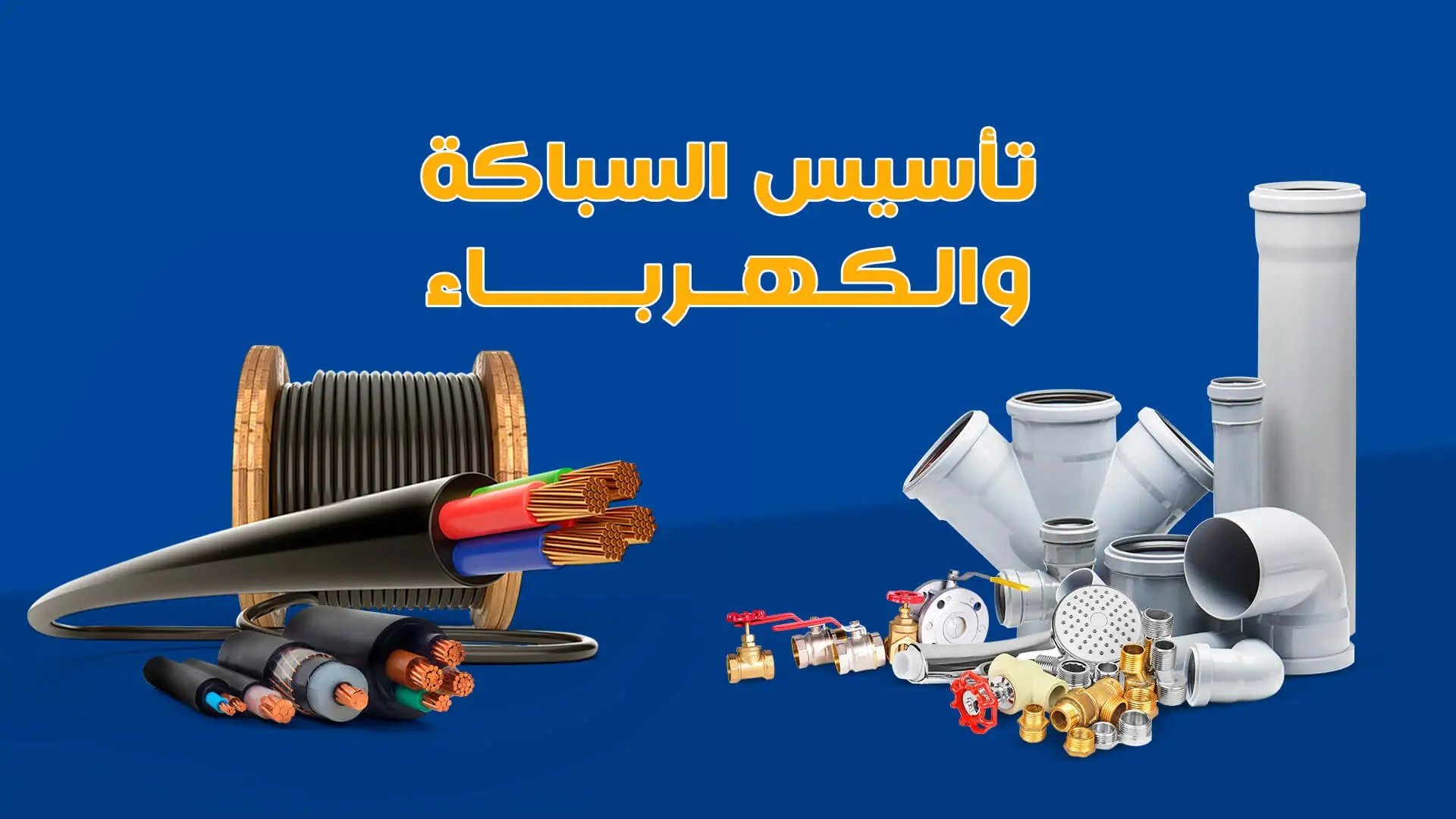Establishing plumbing and electricity is one of the topics that preoccupy many people, due to the great importance it has.
Followers and customers are increasingly searching for all the details related to the ways and means of establishing plumbing and electricity in the correct manner, which will avoid problems later.
Establishing plumbing and electricity
Al-Buruj Saudi Company monitors for its esteemed customers and followers the most important information about the establishment of plumbing and electricity in the following lines:
First: establishing plumbing
Establishing plumbing and electricity is one of the matters that must be taken care of when embarking on the finishing or renovation of an apartment or facility, to avoid potential serious errors that may not be addressed.
When establishing plumbing and electricity, dangerous and destructive water leaks must be avoided to the greatest extent due to their severe impact on the house, and the assistance of technicians specialized in the field of plumbing must be sought to ensure that there is no tampering in the first stages.
Plumbing installation is concentrated in the kitchen and bathroom and includes supplying water inlet and drain pipes, electric heater pipes, as well as sinks and water mixers in kitchens and bathrooms, and installing the toilet base, bathtub or bathtub, etc.
It is recommended to use high-quality products and materials to ensure the success of the process of establishing plumbing and electricity, and to know some of the information that we will provide you in this topic.
The technician determines water levels and land leveling by taking a “SERP” before starting the plumbing installation, and determines the inclinations of drainage and entrances, and uses a laser or traditional level.
The “plumber” uses propylene pipes in 4 colors, where black is used in exposed areas, green is common and widespread in foundations, and red is heat-resistant, while water plants are used in water stations.
The iron is used to weld the water supply pipes straight, then a crank piece is prepared, which is a curved piece of polypropylene that allows the pipes to pass over each other, and the main valve is installed close to the house’s skylight.
When establishing, a water mixer should be chosen and before the finishing stage so that the plumber can determine the type of outlets required, and the distance between the different water outlets in the basin plumbing should be equal.
The technicians and specialists explained the necessity of installing basins and sinks, maintaining the distance between the hot and cold outlets from 8 cm to 10 cm, and providing a hot water outlet and a cold water outlet, and this must be reviewed in the washing machine requirements.
The filter outlet should be placed at a height of 40 cm to 60 cm from the finishing level, and if the filter is without a tank, the plumbing foundation should be at a height of 120 cm from the plumbing finishing level.
The technicians confirmed that the suspended toilet base allows cleaning underneath and can withstand heavy weights. It is installed during the plumbing installation stage on a double wall, and a sink must be installed in the kitchen with a drain for the washing machine.
The plumber conducts a pressure test on the plumbing materials to ensure their strength, then welds the water drainage pipes with thermal adhesive after cleaning them with special cleaning materials.
The technician places a distance between the toilet and the water supply of no less than 25 cm, and it is preferable for the bathtub to be small in size so as not to constrict the space.
Covering and insulating the pipes well is considered one of the most important plumbing works so as not to damage the foundations of the house and all buildings, taking care not to break the concrete bone at all for the passage of extension lines or connections and even electricity to maintain the building.
Experts advise the necessity of verifying and reviewing the main supply points for drinking water, reviewing the inclinations and slopes, conducting a pressure test for the pipes, conducting a leakage test, and ensuring that the water entry pipes are fixed with mortar to ensure that cracking does not occur in the future.
Second: Establishing electricity
The electricity establishment stage is considered the first stage of finishing the apartment, and it involves extending the piping lines that carry all the electricity cables used for home appliances, lighting, air conditioning, and others.
Steps to establish electricity
The process of establishing electricity goes through three steps:
1- Crushing stage
The first stage of establishing electricity is “fracking,” where fractures are made in the walls, ceilings, and floors, where pipes and hoses are extended.
2- The stage of installing the boxes
The technician installs the boxes and pipes in the fractures, and hoses are placed, in which the cables are extended, in preparation for the final stage.
3- Assemble the wires
Installing the wires is the last stage in the process of establishing electricity, as the wires and cables are pulled and passed through the pipes, and then the technician assembles them.
Tips to ensure the success of the electricity establishment phase
- Knowing the type of parts used that are suitable for use (cans, pipes, wires).
- Determine how much cable is needed.
- Determine the carrying capacity of the wires, to suit the number of devices.
Important information about electrical outlet boxes
Wires and cables are collected inside the electrical boxes, after completing the optimal distribution of electricity to the rooms of the house according to the house’s design plan.
The stage of installing electrical boxes
The shapes and types of electrical boxes vary, and they can be installed by ordinary people without relying on technicians. They may be plastic or metal. There are also boxes designated to carry large weights, such as those used in chandeliers or fans.
Where to buy electrical boxes
Electricity boxes can be purchased from stores that specialize in selling electrical appliances, or they can be obtained through sites that provide their services on the Internet.
Learn about the raw materials for electrical boxes
The majority of electrical boxes are made of metal, plastic, or steel, such as those produced specifically for outdoor places that need a high ability to resist external factors, and there are others made of fiberglass and aluminum.
Electrical boxes and ground current discharge
Electrical box manufacturing companies currently rely on making a wire that discharges the ground current in order to ensure safety.
Electrical box shapes
There are several shapes of electrical boxes, including regular, circular, and octagonal boxes that are suitable for installing chandeliers, recessed spotlights, and plaques, in addition to metal boxes, and ceiling fan boxes designed to carry heavy weights.
Information you should not miss before installing electrical boxes
The process of installing electrical boxes is the first stage of construction, which immediately follows breaking. It is a simple process, but it requires precision, as some people make many mistakes during installation.
Al-Buruj Saudi Company provides its valued customers with methods and steps for installing electrical boxes yourself without problems in the following lines:
- Installing electrical boxes on one level and accurately.
- Install key boxes at a height ranging between 110-135 cm, as desired.
- Taking into account the condition of people of determination and wheelchair users, to be close to them.
- Maintain the distance between the frame and its lower edge, and install it between 30 and 40 cm. There are also some who install it at a height of 60 cm.
- Use a regular water level or a laser to make the electrical boxes on one level.
Characteristics of electrical installation pipes
Wires and cables are passed through pipes made of metal or plastic. They may be either rigid or flexible, and they work to protect the cables and wires from any dangers and external influences.
Technicians prefer to use flexible electrical installation pipes, as they help them control them due to their great flexibility, which makes them suitable for any place in the wall, and they do not require heat or welding to bend them.
Advice on electrical pipes
The electrician must be careful to add cables for the shower and satellite, in addition to connecting the Internet cable, and choose a pipe with a large diameter to accommodate the amount of cables, and avoid the need for additional additions and connections in the future.
How are electrical wires pulled inside pipes?
Wires are pulled in the last stages of construction after installing the boxes and extending the hoses. Then the cables are extended and the stage of feeding the pipes with cables comes, which is called the wire pulling stage.
Methods of passing cables in establishing electricity
Cables are passed through pipes and hoses in several ways, including:
First: Passing the cables with liquid
This method relies on pouring a quantity of liquids used for lubrication, lubricating, and lubricating machines into the pipe itself. It is an ideal method for vertical pipes that have a slope.
Second: Passing the cables with gel
The process of passing cables with gel is suitable for places where it is difficult to pour liquid materials, such as ceilings. The wires are coated with a heavy material, such as gel, and then the cable is passed through the pipes.
Third: Passing electricity cables with wax
Power cables are sometimes passed using a hearing aid, which is a method very similar to gel passing, but is more suitable at high temperatures.


